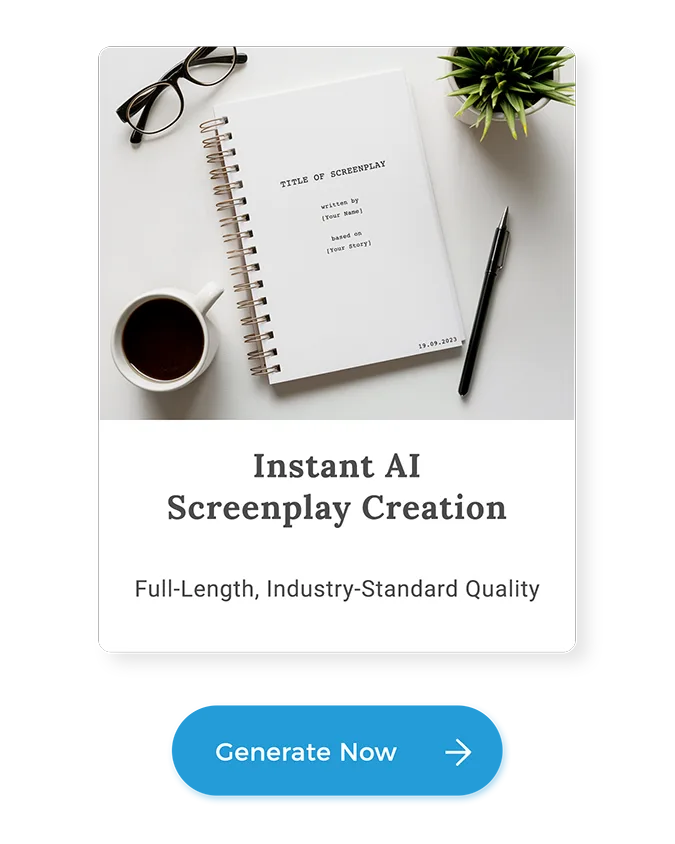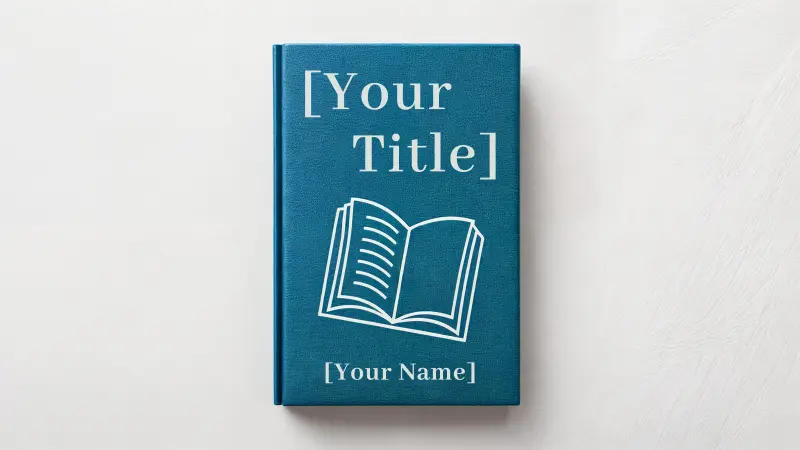Do you have a great story idea, but are not sure how to format it as a screenplay? You’re not alone.
Many screenwriters find themselves caught between creative inspiration and technical formatting needs.
The good news is that screenplay format templates exist. And they can save you hours of frustration and help you focus on telling your story.
In this guide, you’ll read about the best screenplay templates available and understand how to use them.
Let us help you turn your idea into a formatted screenplay that gets noticed.
What Is A Screenplay Format and Why Does it Matter
A screenplay format is the specific way a of script writing so that everyone involved in a production can easily understand how the story plays out on screen.
It follows a set structure for scene headings, dialogue, and actions, making scripts consistent across the industry. Now, let’s understand why screenplay format matters in the first place.
Screenplay Formatting Helps with Readability
Because film and tv show industry professionals read countless scripts, consistent formatting helps them save time while reading scripts.
They can quickly glance through your script and visualize your story without getting distracted by unusual layouts or styles.
Maintaining Proper Formats Can Help with Timing Estimation
A standard formatted script page equals approximately one minute of screen time.
This one-page-per-minute rule allows production teams to plan schedules and budgets based on script length.
Correct Screenplay Formats Can Show Your Professionalism
Correct formatting shows professionalism and respect for industry standards.
It makes your script easier to read and understand. That way, agents, producers, and contest judges can focus on your story, not get sidetracked by formatting issues. Even strong scripts can be overlooked if they don’t meet basic formatting expectations.
Screenplay Formatting Can Give Production Clarity
Each element in a script(scene headings, action, dialogue) serves a specific purpose for different production departments. They are listed below:
Scene headings – Guide locations and scheduling for new scenes (used by ADs, location scouts).
Action lines – Inform direction, stunts, and camera work.
Character names – Help casting, continuity, and performance tracking.
Dialogue – Drives actor delivery and sound planning.
Parentheticals – Cue subtle emotions or line delivery.
Transitions – Aid editors and directors with pacing.
Shots – Optional; help visualize camera work and storyboarding.
Proper formatting ensures that everyone understands their responsibilities.
What Should Your Screenplay Look Like?
In the film and television world, there are several types of scripts: spec scripts, shooting scripts, production scripts, director’s scripts, and more. These serve different purposes, and you tailor them to specific audiences. They could be writers, directors, producers, and editors.
Here’s a common mix-up when it comes to screenwriting: Every screenplay is a script, but not every script is a screenplay.
To some writers, “screenplay” means a shooting script. These are scripts that have camera angles, scene numbers, and film editing notes. But those are for production teams, not for writers.
A shooting script is used during filming and includes technical directions for the crew. A spec script (short for speculative) is what writers usually start with. It’s clean, focused on story and characters, and meant to be read by agents, producers, or contest judges—not filmed yet.
5 Great Screenplay Format Templates and Why You Should Choose Each One
When choosing a template, consider your specific needs, technical comfort level, and how you plan to use your finished screenplay. Here are the top available options:
1. Squibler’s Online Screenplay Template

Squibler offers a user-friendly screenplay writing tool that handles formatting automatically as you write, making it perfect for uninterrupted writing.
Best for: Writers who need help with Feature films, short films, and TV pilots—especially those who want to start writing immediately without learning complex formatting rules.
Key features:
Auto formatting as you type This feature is available in many writing tools, including Squibler. It automatically changes the look and structure of the text while you’re typing it. So, no need to manually apply format styles.
Clean, distraction-free writing space Squibler’s minimalist interface helps you stay focused, making it easier to enter a writing flow state. It’s when you’re fully immersed in your work, ideas flow naturally and time flies.
Cloud-based access This feature helps you write from anywhere and on any device. Your script is always saved and up to date, whether you’re on a laptop, tablet, or phone.
Real-time collaboration tools It lets you share your screenplay with a writing partner, mentor, or editor so they can comment, leave suggestions, or co-write scenes.
No software installation You don’t need to download an extra app. Everything runs in your browser, so you don’t need to download anything or manage software updates.
Seamless export options When you’re done writing your screenplay, Squibler lets you export it in professional formats like PDF or Fountain. These formats are ideal for submitting, sharing, or further developing your script elsewhere.
Example: Squibler’s Adventure Screenplay Template (You’ll have to log in to access these)

2. Final Draft Template (.fdx)
There’s a reason Final Draft templates are a top choice for screenwriters. Its a specialized screenwriting software that provides comprehensive formatting tools trusted by professional screenwriters worldwide. Just pick the type of script you want to work on, and you’re good to go with a layout that meets industry standards. What makes these templates stand out is how well they work with Final Draft’s other tools. SmartType helps autofill character names and locations, ScriptNotes lets you drop comments directly into the script, and the Beat Board gives you a visual way to plan your story.
Best for: Writers serious about submitting to production companies, competitions, or agents.
Key features:
Complete formatting control
Character and location management
Revision tracking tools
Industry-standard file format
Templates for various script types (feature, TV drama, sitcom)
3. Celtx Screenplay Template
Celtx’s screenplay templates bridge the gap between writing and pre-production with templates that help transition from script to screen in seconds. You can start with creating a formatted script, then move straight into storyboarding, shot lists, and scheduling without switching tools.
This is especially useful for collaborative teams. Writers, directors, and producers can all work within the same platform, giving real-time feedback and making production decisions directly from the script.
Best for: Writers who want to move into production planning for TV episodes, web series, and collaborative projects.
Key features:
Team collaboration tools
Integrated pre-production features
Scene heading and breakdowns
Scheduling capabilities
Free basic version with premium options
4. Google Docs Screenplay Formatting Template
If you’re looking for a free way to write and format a screenplay, Google Docs does the job well. You don’t need any specialized software if you go with this option. They’re simple to set up and great if you want to collaborate in real time, especially when you’re just getting a draft done or need early feedback. You won’t get advanced tools like revision tracking or production features, but for writers on a budget, they’re a solid, no-cost option.
Best for: Writers who focus on collaboration and accessibility over advanced formatting features.
Key features:
Some are free to use
Real-time collaboration
Accessible from any device
Familiar interface
5. Microsoft Word Screenplay Template
Word templates provide a more traditional approach to formatting your script that works well for writers who prefer offline tools. These templates offer easy customization that lets you tweak layouts and styles to fit your unique writing process without needing specialized software.
They don’t come with built-in screenwriting tools, but they’re reliable for writers who like to keep things simple and work outside of browser-based apps.
Best for: Writers comfortable with Microsoft Word who want control over their formatting.
Key features:
Works offline
Familiar Word interface
Print-ready formatting
One-time download
Full control over formatting
Characteristics of the Ideal Screenplay Format
Regardless of the genre, every screenwriting template has some characteristics that separate it from the rest.
However, the ideal screenplays all have the following qualities in common:
Comprehensive layout
Contemporary features
Configurability
Creative space
Let’s take a look at each of the characteristics individually.
Comprehensive Layout
If you look at the screenplay for some of the best movies ever made, you’ll find that they all feature a complete and detailed story arc with textbook variations in pacing and dialogue as the story progresses.
Yes, almost all screenplays have some holes that may have been overlooked during writing, but as a structure, they will include all the fundamental aspects of the story they’re telling.
This means that a great script format template will:
Be formatted according to the genre
Have plenty of room for brainstorming and subject research
Feature act, chapter, scene layouts and act breaks
Leave room for character and setting edits (left margin-right margin variation)
Be easy to use for beginners
Other than some specialized genres such as anthology and neo-bizarro, every ideal template has some combination of these qualities.
Contemporary Features
Screenplays have had a somewhat similar structure since, more or less, the start of the previous century.
The same title page, with the same standard Courier font, text indents, scene heading/slugline and subheader prefixes (INT-EXT), action line spacing and layouts, etc. All of it has remained unchanged over the years.
However, with the coming of app-based screenwriting software, we have a ton of contemporary features such as automated page numbers, time of day, parentheticals, and note popups with specific character names.
Even the general rule of ‘one page equals one minute of time on screen’ doesn’t apply in all scripts today.
Configurability
A tight script formatting runs the risk of making your story look and sound similar to all the stories that have used it in the past.
The same events, the same character archetypes, the same movements and delivery, and the same buildup can quickly become boring.
The best script templates have a structure that’s crafted with the story genre in mind but gives the writer room to play around with their characters, settings, etc.
For example, if you’re writing a character who’s learning to write a book, you wouldn’t just show her studying other writers. You might want to show her learning from nature, exploring different creative genres, and using those experiences to change her writing style.
Creative Space
Rigidity is a very common factor in the majority of traditional screenplay formats.
Some rigidity is good since it keeps the story structured and prevents writers from focusing too deeply on one particular aspect while neglecting the rest.
However, screenplay templates should not be too limiting in terms of creative freedom for the writer.
For example, the ideal screenwriting template should allow one character out of the several to experience a different character development stage than the rest, at any particular point in the plot.
This will keep all the characters from looking and sounding like they’ve been crafted from a similar mold and have no unique progression of their own.
Formatting Basics for Your Screenplay
No matter which template you choose, it helps to understand the major elements of a screenplay format. Here are the core components:
Scene Headings (Also Called Sluglines)
Scene heading tells us where to shoot the scene and whether it’s indoors or outdoors. This lets readers and crew immediately know the setting and when the action takes place. They follow a specific structure with proper line spacing:
Interior or Exterior + Location + Time of Day
Example: INT. COFFEE SHOP – DAY
Action Lines
Action lines describe what’s happening on screen. You should write things in the present tense and only include what the audience can see or hear.
Example: John enters the coffee shop, shaking rain from his coat. He scans the room, searching for someone.
Character Names and Dialogue
When a character speaks, their name appears above the dialogue. And, their name is usually in all caps to help production staff identify them quickly. Then you center the dialogue underneath it.
Example:
JOHN
Is this seat taken? I’ve been
looking everywhere for you.
The first time you introduce a character is in the action lines. But watch out for proper line spacing when you do.
Parentheticals
Parentheticals are short directions within dialogue. They help clarify the tone or action. Use these sparingly, as they’re helpful but can become distracting if overused.
Example:
JOHN
(whispering)
Is this seat taken? I’ve been
looking everywhere for you.
Transitions
You use transitions like “Cut To” or “Fade In” to guide how scenes shift. But, most spec scripts keep these to a minimum.
Conclusion
The right screenplay format does more than just make your script look professional.
It transforms how you write by handling technicalities for you. They free you to focus on your characters, their dialogue, and visual storytelling.
Remember that formatting is the foundation for your story.
Your unique voice and perspective will make your screenplay stand out.
Choose the template that feels most comfortable and lets you write with confidence.
Whether you’re writing scripts for the next blockbuster feature or an intimate short film, the perfect screenplay template is out there to bring your vision to life.

FAQs
This section covers the most common questions about formatting your screenplay
What is the easiest way to format a screenplay?
The easiest way is to use an auto-formatting template like Squibler’s. It handles formatting as you type. It eliminates the learning curve associated with screenplay formatting. And it lets you focus on storytelling rather than technical details.
Do I need special software to write a screenplay? Can I use AI to help write my screenplay?
While advanced software isn’t necessary, you can use free templates for Word or Google Docs. Even a dedicated screenwriting platform makes the process easier. And produces more consistent results, especially for longer projects.
Many writers now use AI tools to brainstorm ideas, develop characters, and overcome writer’s block. Squibler’s Smart Writer features can help generate scenes or dialogue while maintaining professional formatting standards.
How many pages should a screenplay be?
Feature film scripts are 90-120 pages (about 1.5-2 hours of screen time). TV dramas average 50-60 pages per episode, while half-hour comedies usually fall between 25-35 pages. Short films vary but generally stay under 30 pages.
What’s the difference between a screenplay template and a screenwriting app?
A screenplay template provides a pre-formatted document structure (in Word or Google Docs, for example). While a screenwriting app formats your script as you write. Free templates on google doc need you to maintain formatting yourself. Whereas apps like Squibler let you handle formatting different elements based on what you’re typing.
How do scene headings help in a screenplay?
Scene headings (sluglines) create visual anchors. These then help readers understand where and when action occurs.



